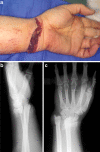Factors associated with infection following open distal radius fractures
- PMID: 19194762
- PMCID: PMC2724624
- DOI: 10.1007/s11552-009-9173-z
Factors associated with infection following open distal radius fractures
Abstract
Open fractures are often classified according to a system described by Gustilo and Anderson. However, this system was applied to open long bone fractures, which may not predict the incidence of infection in open metaphyseal fractures of the upper extremity. Other studies have found that wound contamination and systemic illness were the best predictors of infections in open hand fractures. Our study assessed infection in open distal radius fractures and identifies factors that are associated with these infections. We hypothesize that contamination, rather than absolute wound size, is the best predictor of infection associated with open distal radius fractures. A review by CPT code yielded 42 patients with open distal radius fractures between 1997 and 2002 treated at a level one trauma center. Medical records and radiographic follow-up were reviewed to assess the time to irrigation and debridement, the number of debridements in initial treatment period, the method of operative stabilization, the Gustilo and Anderson type of fracture, the Swanson type of fracture, and description of wound contamination. Forty-two patients were followed up for an average of 15 months (range 4 to 68 months). Twenty-four fractures were classified as Gustilo and Anderson type I, ten were type II, and eight were type III, 30 were Swanson type I, and 12 were Swanson type II. Five of the 42 fractures were considered contaminated. Two were exposed to fecal contamination. The others were contaminated with tar, dirt/grass, and gravel, respectively. Three of 42 (7%) fractures developed infections. All three infected cases received a single irrigation and debridement. Two of five contaminated fractures (40%) developed a polymicrobial infection. Both were exposed to fecal contamination and, therefore, considered Swanson type II fractures. They were classified as Gustilo and Anderson type II and IIIB based solely upon the size of the wound. Both required multiple debridements and eventually wrist fusions. The third infection occurred in a Gustilo and Anderson type II and Swanson type I open fracture treated with one debridement and plate fixation. Hardware removal, debridement, and antibiotics resolved the infection. Three contaminated fractures that healed uneventfully received two debridements. Statistical analysis revealed a correlation with infection and contamination (p = 0.0331). The number of initial debridements played a role in infection, but was not statistically significant. No relationship between infection and time to initial irrigation and debridement, method of fixation, Gustilo and Anderson type, or Swanson type was found. We propose that open distal radius fractures behave differently than open long bone fractures. Infection developed in 7% of the distal radius fractures in our study and was significantly associated with wound contamination. We recommend that contamination be included as factor for prognosis in open distal radius fractures. Contaminated fractures should be treated with multiple debridements as part of the initial plan not based upon subsequent development of an infection.
Figures
References
-
- {'text': '', 'ref_index': 1, 'ids': [{'type': 'PubMed', 'value': '6106173', 'is_inner': True, 'url': 'https://pubmed.ncbi.nlm.nih.gov/6106173/'}]}
- Chapman MW. The use of immediate internal fixation in open fractures. Orthop Clin North Am. 1980;11:579–91. - PubMed
-
- {'text': '', 'ref_index': 1, 'ids': [{'type': 'PubMed', 'value': '445893', 'is_inner': True, 'url': 'https://pubmed.ncbi.nlm.nih.gov/445893/'}]}
- Chapman MW, Mahoney M. The role of early internal fixation in the management of open fractures. Clin Orthop Relat Res. 1979;138:120–31. - PubMed
-
- Chow SP, Pun WK, SO YC, et al. A prospective study of 245 open digital fractures of the hand. J Hand Surg. 1991;16B137–40. - PubMed
-
- {'text': '', 'ref_index': 1, 'ids': [{'type': 'PubMed', 'value': '8515004', 'is_inner': True, 'url': 'https://pubmed.ncbi.nlm.nih.gov/8515004/'}]}
- Duncan RW, Freeland AE, Jabaley ME, et al. Open hand fractures: an analysis of the recovery of active motion and of complications. J Hand Surg. 1993;18A:387–94. - PubMed
-
- {'text': '', 'ref_index': 1, 'ids': [{'type': 'PubMed', 'value': '773941', 'is_inner': True, 'url': 'https://pubmed.ncbi.nlm.nih.gov/773941/'}]}
- Gustilo RB, Anderson JT. Prevention of infection in the treatment of one thousand and twenty-five open fractures of long bones. J Bone Joint Surg. 1976;58A:453–8. - PubMed
LinkOut - more resources
Full Text Sources


